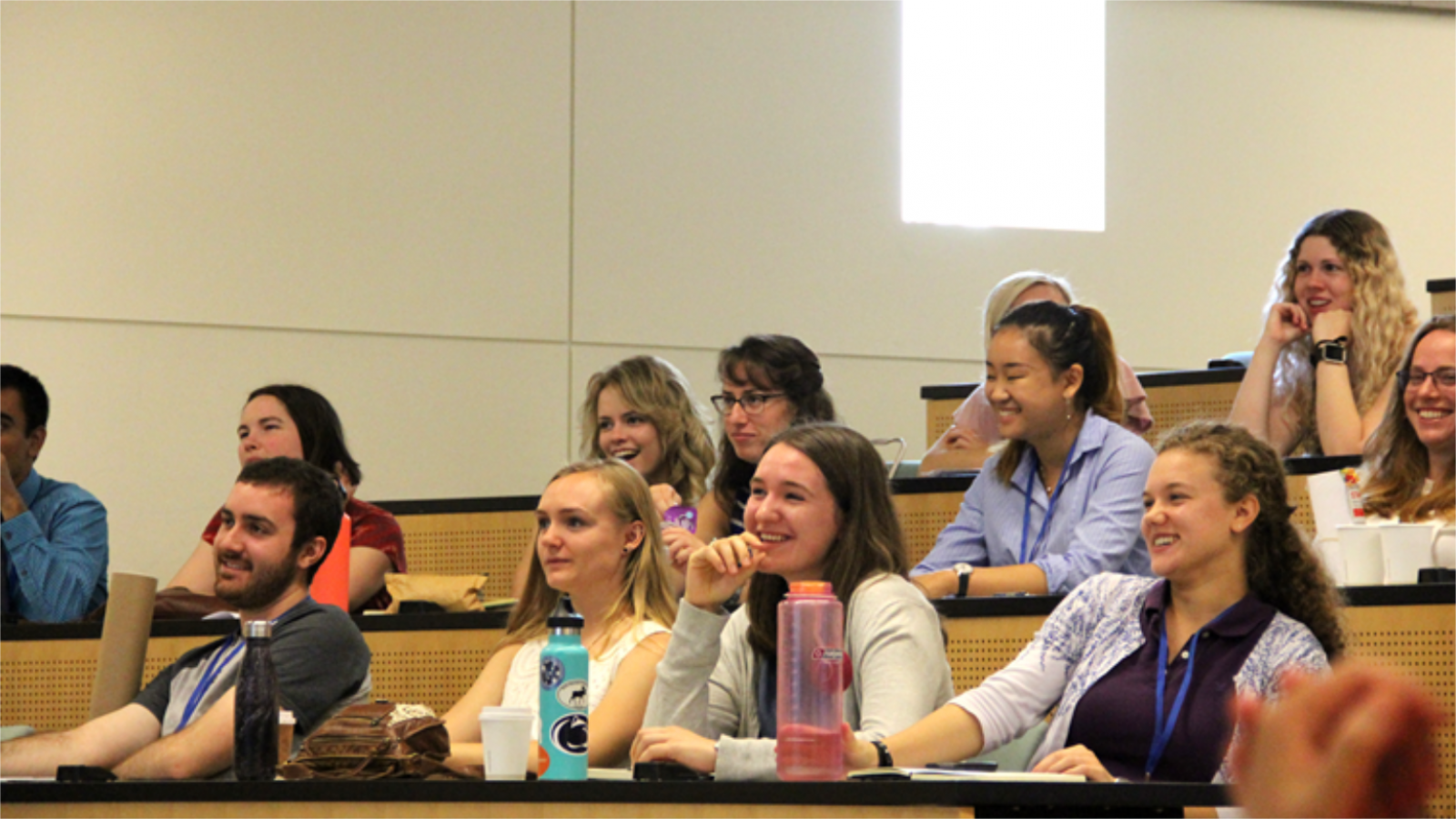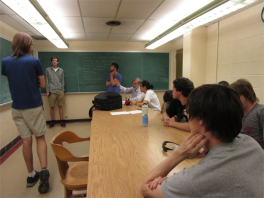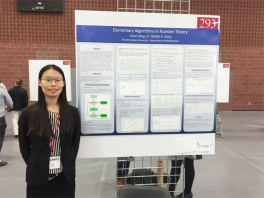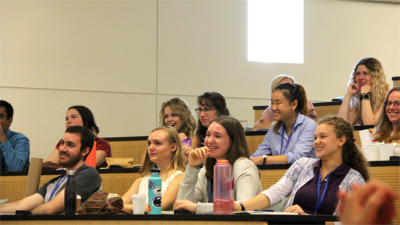
Mathematical Biosciences Institute (MBI) REU Program
Many undergraduate students would like to become involved in research experience in mathematics. The department has created a webpage to identify faculty who may be interested in mentoring undergraduate research. Interested students can then contact such faculty to discuss possible research projects.
Adrian Neff, a fourth-year math major, became involved in two research projects this way. The first was working on elliptic curves with Assistant Professor Ghaith Hiary, and the other was working on Schubert Calculus with Assistant Professor David Anderson. Neff says these projects allowed him to “approach these topics in a much more exploratory manner, which I found to be rather exhilarating.” He presented a poster about his research in the Denman Undergraduate Research Forum last spring.

Professor Sergei Chmutov from the Mansfield regional campus leads an active undergraduate research program on knot and graph theory. Knots and graphs play an important role in physics, biology and computer science. The program led by Chmutov is similar to a usual REU program, with the difference that it is designed for local math honors students. This program has run each summer since 2005, with 169 students passing through it thus far. The students have published nine papers in research journals and presented at six professional conferences and seminars and 52 undergraduate research conferences.
Caleb Dilsavor, a doctoral student in the department who also earned his BA from Ohio State, participated multiple times in the knot and graph theory summer program. “I wanted to try my hand at research as early as I could,” Dilsavor said, adding, “by the time of my second [summer], I was able to do some of my own research and even got accepted to present at the 2016 Young Mathematicians Conference.”
Another participant, Michael Heinz, a third-year undergraduate math and physics double major, worked on a project in virtual knots with two other students. After the project ended, he started another research project with Professor Ovidiu Costin, studying methods of re-summing divergent series. “The experience has been almost overwhelming — every week I am learning so many new things,” said Heinz, adding, “the feeling of discovering something out yourself about your research topic is absolutely exhilarating.”
Another undergraduate research program in the field of planar algebras was run by Assistant Professor David Penneys this summer. One of the applicants was Srivatsa Srinivas, who is interested in eventually becoming a professional mathematician. Srinivas was elated that he was accepted into the program, saying he “never dabbled in mathematical research before” and “was a bit nervous” leading up to the start of the program. But the project went smoothly, resulting in a paper that has since been submitted for publication.

Even non-math majors have become involved in undergraduate research in the department. Lillian Zeng majored in finance and minored in math and computer & information science. During her second year at Ohio State, she wanted to continue work in math and started to look for opportunities in the Department of Mathematics. She worked with Hiary on “algorithms in number theory.” Zeng says the project needed a lot of programming and understanding of complicated algorithms, and she realized how much she liked the implementation part of research. The experience made her decide to work as a quantitative analyst in the future. Zeng graduated this past year and has started a master’s program in risk management and financial engineering at Imperial College London.
The Mathematical Biosciences Institute (MBI) offers research experiences to undergraduate students from around the country. The MBI annually hosts a multi-institution REU program funded by the National Science Foundation in the mathematical biosciences. The objectives of the program are: to introduce a diverse cohort of undergraduate students to the mathematical biosciences, broadly interpreted to include areas such as biostatistics, bioinformatics and computational biology, as well as biologically inspired mathematical modeling; to encourage students to pursue graduate study in the mathematical biosciences; and to increase the number of students who enter the workforce with training in this field.
Each year, 10 to 12 students from around the country work on projects in areas such as molecular evolution, neuronal oscillatory patterning, cancer genetics, epidemic and vaccination strategies, and animal movement. Participants work individually or in pairs under the guidance of expert mentors to make specific research contributions in these areas, often leading to a peer-reviewed publication and conference presentations. The REU program incorporates various professional and research-skills development activities throughout the summer to ensure the participants’ success in completing their summer project and prepare them for graduate study or entering the workforce.
Student participants come from a wide variety of schools and scientific backgrounds. Last year’s projects included:
- Using a Mathematical Model of Sepsis to Predict Survivability Conditions
- Implementation of Advanced Topology Optimization Methods
- Modeling Slime Mold Decision-Making as Systems of Coupled Oscillators
- Assessing the Value of ChIP Data
- Emergent Oscillations in Electrically Coupled Neuronal Networks

MBI’s REU program consists of three parts:
- Week 1: Mathematical Biosciences Bootcamp. The first week is held at the MBI,where participants are introduced to various areas of the mathematical biosciences via scientific lectures, software tutorials, breakout sessions with MBI postdocs, discussions about presentation skills and the academic publishing process, and visits to various biological labs on campus.
- Weeks 2-8: Mentored Research Experience. During this second component of the program, students work on a mentored research project individually or in pairs at one of the REU host sites. Participants also attend a weekly online seminar series and virtual all-program meeting. Last summer’s seminar speakers included researchers with PhDs in physics, math, statistics, computer science and biology, including some current and former MBI postdocs.
- Week 9: Capstone Conference. For the final week of the program, the students participate in the MBI’s national Capstone Conference. This is a student-centered conference featuring talks and posters by students from schools around the country who have done research in mathematical biology, keynote talks by prominent mathematical biologists, a graduate studies recruitment fair, panels on graduate school and career opportunities, and other special features including a conference dinner and social event.
If you would like to make a gift to the “Mathematics Undergraduate Student Support Fund,” Fund Number: 308105, click here or email math@osu.edu. This fund supports research projects of math undergraduate students, their travel to research conferences, scholarships and expenses associated with the organization of math related events.
[Photo credits: 1. Diana DeVol Bevilacqua; 2. Justin Shen; 3. MBI]
